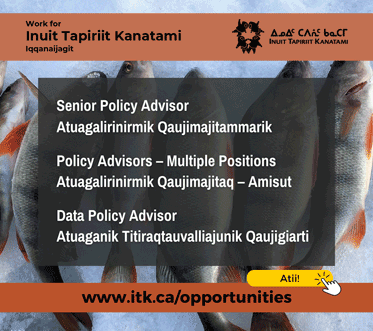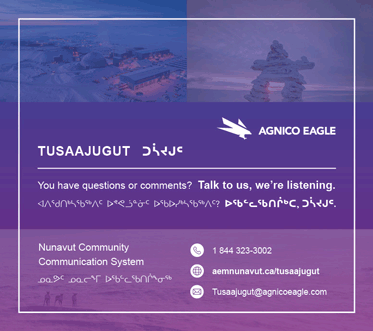Beluga populations on shortlist for SARA
Hunters oppose “at risk” designation as unnecessary and obstructive
SARA MINOGUE
The Department of Fisheries and Oceans is touring 14 Nunavut communities to hear from the public before deciding whether to list three beluga whale populations under the new Species at Risk Act.
“I’m here to hear what people have to say,” said Holly Cleator, a species at risk biologist based in Winnipeg, in between public consultations in Cape Dorset and Iqaluit.
Nunavummiut consulted have so far been unanimous: they don’t want to see changes in status that would result in hunting quotas.
After meeting with Cleator in the Ummimak School gym in Grise Fiord on Jan. 10, the Iviq Hunters and Trappers Association planned to make a formal resolution opposing a whale quota.
“Our beluga here are healthy and there’s no need for people to get alarmed,” said Jaypatee Akeeagok, chair of the Iviq HTO.
“The harvest here and the management here is voluntary. The catch here averages about 14 animals per year. Even if DFO try to indicate to us they’re under a certain status, it would not make any sense for here because we have fairly good abundance of beluga.”
Scientists estimate there are more than 21,000 whales in the Eastern High Arctic-Baffin Bay beluga population, but are concerned about threats including polar bears, killer whales, ice entrapments, noise disturbance, climate change, and especially, over-harvesting in Greenland.
“Our position is that the community of Grise Fiord is not over-harvesting. We are managing it to the needs of the community itself, so we do not want to be penalized for another body’s over-harvesting.”
Akeeagok was pleased with the “good, frank discussion,” that took place at the meeting, but said that he was still concerned about COSEWIC, the Committee on the Status of Endangered Wildlife, taking charge of Nunavut’s whales.
“Whenever the federal government makes rules and regulations to govern wildlife, they listen to that body more than any other body, even though… none of the board members have ever been up here by themselves physically to determine whether their judgment is accurate or not,” Akeeagok said.
Simon Idlout, a beluga hunter and board member of the Resolute Bay Hunters and Trappers Association, attended a public meeting in his community on Jan. 8.
That meeting was useful because hunters were able to point out errors in DFO maps showing migration patterns.
Some hunters also disputed the scientists’ belief that Greenland and Canada share one whale population.
It’s easy to tell if a whale is from Greenland, Idlout says, because they are easily scared. Greenlanders hunt using kayaks and harpoons, which means whales from there are extra sensitive to outboard motors and rifles. Yet in Pond Inlet, whales are not afraid at all, and they are easy to hunt.
Idlout found it hard to take seriously information gathered in two-week field research studies, and even invited scientists to spend an entire summer with him to see just how many whales there are in Resolute Bay.
“I’m very happy if my boat in the summer is not tipped over by the whales,” Idlout said.
Last March, the scientists and conservationists of COSEWIC reviewed a combination of scientific data and traditional knowledge and found that all but one of seven beluga whales populations in the Canadian Arctic are at risk.
They recommended listing the Cumberland Sound beluga population as “threatened” and the Western Hudson Bay belugas and the Eastern High Arctic-Baffin Bay belugas as a “special concern.” Under SARA, which came into effect in June 2003, species can be listed as extinct, extirpated, endangered, threatened, or a “special concern.”
Listing a species under SARA can have consequences for local hunters.
If a beluga population is listed as “threatened,” anyone who kills, harms, harasses, possesses, collects, buys, sells or trades a whale in that population can be charged with a federal offense.
If a beluga population is listed as a “special concern,” hunters may be subject to a management plan, designed in collaboration with the DFO. The plan could mean a quota or other community management system.
Before any aquatic species is added to the SARA list, the DFO must review COSEWIC’s recommendation.
Cleator will take the comments she hears from community members and HTOs back to DFO Minister Geoff Regan, who will consider the social and economic implications, as well as the cost to Canadians of endangering a species, before deciding whether or not to approve the recommendations.
Public consultations will continue in Kimmirut, the Kivalliq region, Sanikiluaq and Igloolik over the next two months. People can also submit opinions by mail, email or telephone.
The Nunavut Wildlife Management Board will also have a chance to approve or reject COSEWIC’s recommendations.
A decision will likely be made by January 2006.





(0) Comments